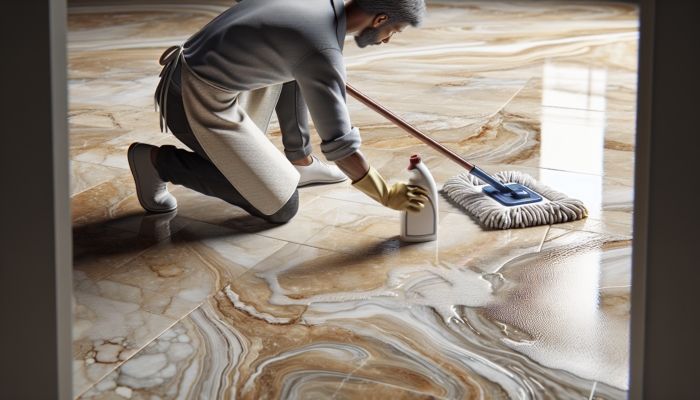Essential Preparation Techniques for Thoroughly Cleaning Your Travertine Floors
Completely Clear the Area for an Uninterrupted Cleaning Experience

Prior to commencing the process of cleaning your travertine floors, it is crucial to prepare your environment meticulously to ensure outstanding results. This preparation involves the complete removal of all furniture, rugs, and miscellaneous items from the space. By doing so, you not only gain unobstructed access to the entire travertine surface but also significantly reduce the risk of scratches or damage to your belongings during the cleaning process. Take this opportunity to conduct a thorough inspection of the floor for any noticeable stains or areas that may require extra attention later. A clean and organised environment lays the groundwork for a thorough and effective cleaning venture, ultimately leading to exceptional results that enhance the beauty of your home.
Employing Efficient Sweeping Techniques for Pristine Travertine Floors
Now that the area is free of obstacles, it’s time to concentrate on effectively sweeping the floor. Utilise a broom fitted with soft bristles, as this is vital since harsher bristles can inadvertently scratch the delicate travertine surface. The sweeping process serves as an essential first step in eliminating loose dirt and debris, acting as your initial defence against grime build-up. Pay special attention to corners and edges, where dust tends to accumulate, ensuring a comprehensive clean. A thorough sweeping not only enhances the effectiveness of the subsequent vacuuming and mopping phases but also safeguards the natural beauty of your exquisite travertine floors while contributing to a cleaner and more inviting environment in your home.
Enhancing Cleaning Efficiency with Comprehensive Vacuuming Techniques for Travertine
After diligently sweeping, the next essential step is to employ a vacuum cleaner fitted with a soft brush attachment. This action is crucial for capturing fine particles of dirt and dust that may have slipped past the broom. Ensure that your vacuum cleaner is set to the appropriate height to avert any potential scratches or damage to the travertine surface. Direct your vacuuming efforts across all areas, focusing particularly on seams and grout lines where dirt can easily accumulate. Vacuuming not only boosts the overall cleaning effectiveness but also significantly contributes to the ongoing maintenance of your travertine floors, ensuring they remain in pristine condition and inviting for years to come, preserving their elegance and charm.
Mopping with a pH-Neutral Cleaner for Optimal Care of Your Travertine

Once all loose debris has been successfully removed, the next logical step is to mop the travertine floor. It is highly advisable to use a pH-neutral cleaner, as these products are specifically formulated to be gentle on stone surfaces while effectively lifting dirt and grime. Pair this cleaner with a microfiber mop, which excels at removing stubborn residue while avoiding scratches. Ensure that the mop is damp rather than overly wet, as excess moisture can lead to unsightly water spots or potential damage to the stone. As you mop, work in sections to guarantee complete cleaning, paying particular attention to stained areas. A careful and methodical approach to mopping will yield the most satisfying results for your travertine flooring, restoring its original elegance and ensuring its continued beauty.
Ensuring Thorough Drying of Your Floors for a Lasting Shine
After the mopping process is complete, it is essential to allow the floor to air dry thoroughly. This step is vital, as any residual moisture can lead to unsightly water spots or even discolouration over time. If you wish to expedite the drying process, consider using a clean, dry towel to gently buff the surface. This technique not only aids in drying the floor quickly but also enhances its shine, leaving your travertine looking immaculate and well cared for, with a finish that reflects its natural beauty and charm, ensuring that it remains a stunning feature of your home for years to come.
Choosing the Most Effective Cleaning Products for the Optimal Maintenance of Travertine
The Vital Importance of pH-Neutral Cleaners in Caring for Travertine

When mastering how to clean travertine floors effectively, selecting the right cleaning products is critical. A pH-neutral cleaner is particularly beneficial for maintaining the integrity of the travertine surface. These specialised cleaners are designed to efficiently eliminate dirt and grime without risking damage to the stone, which can occur with acidic or harsh cleaning agents. When selecting a cleaner, always examine the labels thoroughly to ensure they explicitly mention pH-neutral properties. This consideration will help to maintain your travertine in a clean state while ensuring it remains well-preserved for many years to come, guaranteeing its continued beauty and functionality.
Avoiding Harsh Chemicals to Protect Your Travertine Floors
Many common household cleaners, particularly those containing acidic or abrasive components, can inflict significant harm on your travertine floors. These harsh substances can etch, scratch, or dull the surface, leading to costly repairs or intensive restoration efforts. It is advisable to avoid using vinegar, lemon juice, or any products containing bleach or ammonia. Instead, focus on utilising specialised travertine cleaners or formulations specifically designed for natural stone surfaces. This approach not only helps to maintain the stone’s natural beauty but also ensures a safe and effective cleaning process, preserving its aesthetic appeal for years to come.
Creating Your Own Eco-Friendly Cleaning Solutions for Gentle Care
For those who prefer an eco-friendly cleaning approach, consider crafting your own cleaning solution. A simple mixture of warm water and a few drops of mild dish soap can yield a gentle yet effective cleaner. This homemade mixture is safe for use on travertine and can effectively tackle light stains and dirt. Apply the solution using a soft mop, ensuring to rinse it thoroughly with clean water to eliminate any residue that could dull the stone over time. This natural technique not only protects your floors but also contributes to a more sustainable cleaning routine, promoting a healthier living environment in your home.
The Advantages of Using Eco-Friendly Cleaners for Travertine Maintenance
Utilising eco-friendly cleaning products not only benefits your travertine floors but also has positive implications for the environment. Many brands now offer biodegradable cleaners that effectively clean without containing the harmful chemicals typically found in traditional cleaning agents. Look for products specifically marketed as safe for natural stones. By choosing these environmentally friendly alternatives, you can achieve a clean and safe living space while also playing your part in protecting our planet for future generations, ensuring a sustainable approach to home maintenance that reflects your commitment to both hygiene and environmental responsibility.
The Significance of Regular Maintenance Products for Long-lasting Travertine Floors
To ensure the longevity and aesthetic appeal of your travertine floors, consider using specialised maintenance products designed specifically for natural stone. Travertine sealers and cleaners can provide crucial protection against stains and wear, keeping your floor looking pristine and well-maintained. Regular applications of a high-quality sealer will create a barrier against spills and stains, simplifying your routine cleaning efforts. For optimal results, always adhere to the manufacturer’s recommendations regarding application frequency and methods to ensure the best care for your travertine surfaces, allowing them to shine beautifully for years ahead and preserving their natural elegance.
Implementing Effective Cleaning Techniques for Your Travertine Floors
Perfecting the Technique of Mopping Your Travertine Floors for Best Results
Mopping is a fundamental aspect of the cleaning process when learning how to clean travertine floors properly. Start with a clean mop and your chosen pH-neutral cleaner. Dampen the mop with the cleaning solution, ensuring it is not overly wet to prevent water spots or potential damage to the stone. Begin mopping from one corner of the room and methodically work your way towards the exit, ensuring that all areas are covered without stepping on wet surfaces. The key to effective mopping is to regularly rinse the mop in clean water to avoid redistributing dirt back onto the floor. This method not only facilitates a more thorough clean but also preserves the natural shine and beauty of your travertine floors, ensuring they remain a stunning feature of your home for years to come.
Effective Strategies for Spot Cleaning Stains on Your Travertine Surfaces
Stains on travertine can become particularly stubborn if not addressed promptly. For immediate action, utilise a soft cloth dampened with an appropriate stain remover, focusing directly on the stained area. For organic stains, a mixture of hydrogen peroxide and baking soda can often yield effective results. Apply this solution to the stain, allowing it to sit for several minutes before gently scrubbing with a soft brush. Afterward, rinse thoroughly with clean water and dry the area with a towel. Prompt action is essential to prevent discolouration and ensure the enduring beauty of your travertine floors, helping to maintain their elegant appearance over time and enhancing their overall appeal.
The Necessity of Thoroughly Drying the Surface After Cleaning
After completing both mopping and spot cleaning, drying the surface is crucial to prevent the formation of water marks and streaks. Use a clean towel or microfiber cloth to gently buff the floor, enhancing both shine and cleanliness. This step is particularly significant in high-traffic areas where moisture can lead to accelerated wear and tear. By establishing a routine of drying the surface after cleaning, you significantly contribute to the longevity of your travertine, ensuring it remains aesthetically pleasing and retains its stunning appearance for years to come, thus safeguarding your investment in this exquisite flooring material.
Applying Sealer to Your Travertine for Enhanced Protection Against Stains
Sealing your travertine floors is a critical aspect of maintenance that provides essential protection against stains and moisture damage. Opt for a high-quality sealant specifically designed for natural stone and apply it following the manufacturer’s guidelines. Typically, this involves thoroughly cleaning the surface before applying the sealer with a clean mop or cloth. Ensure to allow adequate drying time before walking on the area to achieve optimal results. Regular sealing, ideally once a year, will significantly enhance the durability and visual appeal of your travertine, ensuring it continues to be a stunning feature in your home while safeguarding your investment in this beautiful flooring material.
Implementing Effective Strategies for Cleaning Grout and Seams in Travertine
Cleaning Grout Lines to Achieve a Pristine Look for Your Floors
Grout lines can easily become discoloured and grimy, detracting from the overall beauty of your travertine floors. To clean them effectively, utilise a soft brush along with a suitable grout cleaner that is safe for the surrounding stone. Apply the cleaner to the grout lines, allowing it to sit for a few minutes before gently scrubbing with the brush. This method will help lift dirt and stains without damaging the travertine. Rinse thoroughly with clean water afterward, and dry the area to prevent any residue from dulling the surface, thus maintaining the aesthetic quality and charm of your beautiful flooring.
Applying Grout Sealer for Long-lasting Protection of Your Travertine Grout
Once your grout lines have been thoroughly cleaned, consider applying a grout sealer. This protective barrier helps prevent future staining and reduces the accumulation of dirt. When sealing grout, ensure that the surface is completely dry. Use a small brush or applicator to apply the sealer, focusing solely on the grout lines. Allow the sealer to cure as per the manufacturer’s instructions. Regular sealing of grout not only maintains its appearance but also prolongs the life of your travertine flooring by preventing moisture penetration and decay, ensuring lasting beauty and integrity for your home.
Maintaining Seams to Preserve the Aesthetic Appeal of Your Travertine Floors
Regular inspection and maintenance of seams in travertine are essential to prevent dirt buildup and to preserve a polished appearance. Seams can accumulate debris and stains if left unaddressed, diminishing the visual appeal of your floors. A soft brush or a damp cloth can be effectively used to clean these areas. If necessary, apply a mild cleaner, ensuring that the seams are thoroughly dried afterward. By incorporating seam maintenance into your regular cleaning routine, you can ensure that your travertine flooring remains as stunning and impressive as it was on the day it was installed, upholding its beauty and charm for years to come.
Implementing Strategies to Prevent Damage to Your Travertine Floors
Utilising Protective Mats at Entryways for Enhanced Floor Preservation
One of the simplest yet most effective methods to maintain the integrity of your travertine floors is by placing protective mats at entryways. These mats act as a primary line of defence, capturing dirt, grit, and moisture from shoes before they can reach your floors. Opt for mats that are both absorbent and easy to clean. Regularly shake out or wash these mats to maintain their effectiveness. This small yet significant effort can dramatically reduce wear and tear on your travertine, preserving its beauty and extending its lifespan over time, ensuring a welcoming environment in your home that reflects your attention to detail.
Preventing Scratches to Maintain a Flawless Finish on Your Travertine
Preventing scratches is essential for maintaining the pristine appearance of your travertine flooring. One effective strategy is to attach felt pads to the legs of your furniture. These pads create a protective barrier between hard surfaces and your flooring, minimising the risk of scratches that can occur when moving furniture. Additionally, avoid wearing shoes with hard soles on the travertine, as this can also contribute to surface scratching. By being mindful of how you interact with your travertine floors, you can keep them looking beautiful and well-maintained for many years ahead, ensuring their long-lasting appeal and preserving their natural beauty.
Limiting Moisture Exposure to Ensure Long-lasting Travertine Floors
Moisture poses a significant threat to travertine floors, making it vital to promptly wipe up spills. Water can seep into the porous surfaces of travertine, leading to stains and potential damage. Use a soft cloth to gently blot spills immediately, and if the area becomes wet, ensure it is thoroughly dried. If your space tends to retain moisture, consider using a dehumidifier to maintain optimal conditions for your travertine. By taking these preventive measures, you not only safeguard your investment but also preserve the natural elegance and beauty of your flooring, enhancing its longevity and resilience against wear and tear.
Establishing a Regular Maintenance Schedule for Optimal Care of Travertine Floors
Creating a Daily Cleaning Routine for Optimal Travertine Care
Establishing a daily cleaning routine is paramount for maintaining your travertine floors in peak condition. This can be as straightforward as sweeping or vacuuming to eliminate dust and debris. By addressing dirt and grime daily, you prevent it from accumulating into more substantial issues that become increasingly difficult to clean. Additionally, consider conducting quick spot checks for any spills or stains, addressing these immediately to keep your floors looking immaculate. A consistent daily routine forms the foundation for effective long-term maintenance of your travertine, ensuring its enduring beauty and charm throughout your home.
Conducting a Weekly Deep Clean for Enhanced Longevity of Your Travertine Floors
In conjunction with daily upkeep, it is advisable to conduct a more thorough cleaning on a weekly basis. This involves mopping with a pH-neutral cleaner to eliminate any build-up of dirt or grime that daily cleaning may overlook. Depending on the foot traffic in your home, you may wish to increase the frequency of your deep cleaning sessions. As part of your weekly routine, also ensure to inspect for any stains or damages that may require immediate attention. A dedicated weekly deep clean will preserve the luster and elegance of your travertine floors, ensuring they remain a stunning focal point in your home for years to come, enhancing their visual appeal and durability while safeguarding your investment.
The Importance of Annual Sealing for the Longevity of Your Travertine Floors
A crucial component of your maintenance schedule is the annual reapplication of a travertine sealer. This step is essential as it helps to protect the stone from moisture and staining while enhancing its natural colour and finish. Before sealing, ensure that the floor is thoroughly cleaned and dried. Carefully follow the manufacturer’s instructions for application to achieve the best results. Regular sealing not only extends the life of your travertine but also keeps it looking as beautiful and vibrant as the day it was installed, safeguarding your investment for the long term, while maintaining its captivating allure and charm.
Addressing Common Issues with Your Travertine Flooring
Effectively Removing Unsightly Etch Marks from Travertine Surfaces
Etch marks can occur on travertine floors as a result of contact with acidic substances, creating unsightly blemishes that mar their appearance. To effectively remove these marks, utilise a travertine polishing powder specifically designed for this purpose. Apply the powder to the affected area and gently buff it with a soft cloth or polishing pad. This process not only eradicates etch marks but also restores the shine to your floors, enhancing their overall aesthetic. Consistent maintenance and prompt attention to spills can greatly mitigate the likelihood of future etching on your beautiful travertine surfaces, ensuring they remain stunning and well-kept over time.
Repairing Chips and Cracks in Travertine Flooring for a Flawless Appearance
Small chips and cracks are common issues in travertine flooring, often resulting from heavy impact or general wear over time. Fortunately, these imperfections can be easily remedied using a travertine repair kit, which typically includes resin or epoxy materials. Follow the instructions provided with the kit to fill in the damaged areas, smoothing it out to blend seamlessly with the surrounding stone. For larger repairs, it may be wise to consult a professional to ensure that the restoration is executed correctly and effectively. Keeping your travertine floors in top condition necessitates prompt attention to any damages that arise, preserving their beauty and functionality for years to come.
Preventing Efflorescence on Travertine Surfaces for Lasting Beauty
Efflorescence, characterised by the appearance of white powdery deposits on the surface of your travertine, can be effectively prevented through proper ventilation and moisture control. Ensure that your floors are not exposed to excessive water or humidity, particularly in moisture-prone areas like bathrooms or basements. If you notice efflorescence forming, clean it immediately using a pH-neutral cleaner, followed by thorough drying of the area. Consistent maintenance and a keen awareness of moisture levels in your home will help keep your travertine looking its best and free from unattractive deposits, preserving its natural elegance and charm for years to come.
Cleaning Stains and Discolouration on Your Travertine Floors
Stains and discolouration on travertine can be distressing, but with the right approach, they can often be effectively addressed. Using a pH-neutral cleaner and a soft cloth, gently clean the stained area, taking care not to rub too hard, as this could exacerbate the damage. For particularly stubborn stains, consider using a specialised stain remover, applying it according to the product instructions for the best outcome. Regular cleaning and prompt attention to spills will significantly reduce the likelihood of permanent discolouration on your travertine floors, helping them maintain their natural beauty and enhancing their overall appeal for years to come.
The Necessity of Properly Sealing Travertine Surfaces for Effective Protection
Proper sealing of your travertine surfaces is essential for providing robust protection against stains and moisture. A penetrating sealer should be applied to ensure that it seeps into the stone, creating a durable shield against harmful elements. Reapply the sealer as recommended by the manufacturer, typically on an annual basis, to maintain this protective barrier. Regular sealing not only enhances the beauty of your travertine but also ensures its durability, preserving its elegant appearance for many years to come while safeguarding your investment in this exquisite flooring material.
Frequently Asked Questions Regarding the Maintenance of Travertine Floors
How often should I clean my travertine floors to maintain their pristine look?
It is advisable to sweep or vacuum your travertine floors daily and mop them weekly to maintain their appearance and protect against the accumulation of grime and dirt, thereby ensuring their longevity and beauty.
Can I use vinegar to clean travertine floors, or will it cause damage?
No, vinegar is acidic and can severely damage the surface of travertine. Instead, opt for pH-neutral cleaners specifically designed for natural stone care, which are safe and effective for maintaining your travertine flooring.
What should I do if I spill something on my travertine floor?
Wipe up spills immediately with a soft cloth to prevent staining. For stubborn stains, use a pH-neutral cleaner and buff the area gently to restore its original appearance, ensuring it remains pristine and beautiful.
How do I effectively remove etch marks from travertine surfaces?
Utilise a travertine polishing powder to buff out etch marks. Be sure to follow the product instructions for the most effective results, ensuring your floors maintain their shine and exquisite appearance.
Is it really necessary to seal travertine floors for protection?
Yes, sealing travertine is crucial for safeguarding it against stains and moisture. It is recommended to apply a sealer annually to maintain its beauty and durability, ensuring its longevity and charm.
Are there any eco-friendly cleaning options suitable for travertine?
Yes, a mixture of warm water and mild dish soap can serve as an effective and eco-friendly cleaning solution for travertine floors, helping to maintain their beauty without harmful chemicals.
How can I prevent scratches on my travertine floors from damaging their finish?
Place felt pads under furniture legs and avoid dragging heavy objects across the floor to prevent scratches and maintain the floor’s pristine condition, ensuring its enduring beauty and elegance.
What is efflorescence, and how can I effectively prevent it from occurring?
Efflorescence is a white powdery residue caused by moisture. Prevent it by ensuring proper ventilation and promptly addressing any water damage that arises, safeguarding your floors and maintaining their beauty.
How do I clean grout lines in travertine tiles effectively?
Utilise a soft brush and an appropriate grout cleaner to scrub the grout lines, then rinse thoroughly with clean water to ensure a spotless finish, maintaining your floors' aesthetic appeal and integrity.
What type of mop is recommended for cleaning travertine floors safely?
Use a microfiber mop along with a pH-neutral cleaning solution to avoid scratching and ensure a gentle yet effective clean, preserving the integrity and beauty of your travertine floors.
The post How to Clean Travertine Floors: A Comprehensive Guide appeared first on https://tilecleaningsurrey.co.uk
The Article Cleaning Travertine Floors: Your Complete Guide appeared first on https://fabritec.org
The Article Travertine Floors Cleaning: The Ultimate Guide Was Found On https://limitsofstrategy.com

